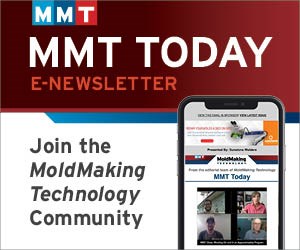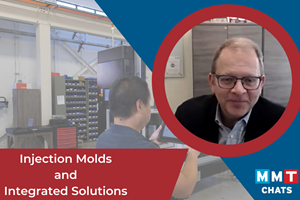
Mold builders can seize opportunities in medical manufacturing as demand for precision molds grows, driven by miniaturization, LSR use and auto-injectables, to name a few, requiring advanced machining, automation and tight-tolerance molding. Source: M.R. Mold & Engineering
A common thread in conversations on the show floor during MD&M West in Anaheim last week was that most mold builders are operating at full capacity and are uncertain about how current and potential tariffs might impact material costs and international trade relationships. Despite these concerns, moldmakers are adapting by strengthening their domestic partner networks to handle overflow work while focusing internally on efficiency and continuing to address the skilled labor shortage. This business climate has created a situation where moldmakers are simultaneously managing high volumes, navigating trade uncertainties and investing in technologies to streamline their operations.
Many mold builders I spoke with are repositioning themselves in the value chain and taking a more active role in managing the impact of new technology on mold designs. Others have expanded their customer offerings. They're involved earlier in projects, providing upfront engineering services and developing new revenue streams through mold refurbishment and repair services. Their focus on comprehensive metrology and tool validation services is reducing overall lead times and optimizing development costs. This evolution from pure manufacturing to full-service solution providers is strengthening customer relationships.
These business model changes align with current medical manufacturing trends. The push toward miniaturization, increased use of LSR and growing demand for auto-injectables, for example, all of which require high precision in mold machining, automation systems and molding processes to maintain tight tolerances and ensure repeatability.
Automation has shifted from an option to a necessity, as shops implement robotics and AI-driven systems across their operations. These solutions are streamlining everything from mold design to production and inspection, helping maintain quality standards while reducing lead times and labor costs.
Integrating IoT and real-time data analytics means smart molding, using sensors to monitor temperature, pressure and cycle times. This level of control allows moldmakers to trace critical parameters throughout the production cycle and make adjustments as needed, and it is proving invaluable for medical applications where consistency and precision are essential. Predictive maintenance capabilities, enabled by real-time data, are also helping to minimize downtime and enhance production efficiency.
Digital twin technology is changing how shops approach new projects, enabling design simulation and optimization before cutting steel. One moldmaker at the show shared how they identified potential flow issues through digital simulation, saving weeks of development time that would have been spent troubleshooting physical parts. The technology has proven especially valuable for complex geometries in modern medical devices.
Conformal cooling continues to be essential for maintaining precise temperature control in medical applications. Maintaining consistent temperature throughout the molding cycle is particularly important when working with the new generation of biocompatible materials entering the market. Similarly, laser texturing enables the creation of specialized surface characteristics for medical devices, such as self-cleaning surfaces and reduced friction in moving parts.
Sustainability initiatives continue across the industry. More moldmakers are adapting their processes to work with recycled polymers and biodegradable materials. This shift isn't just about environmental consciousness – it's becoming a business imperative as medical device manufacturers increasingly prioritize sustainable solutions in their supply chains. Energy-efficient processes and material optimization are helping control costs while meeting these new market demands.
Regulatory compliance remains a challenge, but technology is providing solutions. AI-powered monitoring systems and blockchain technology for traceability are helping simplify what has traditionally been a complex aspect of medical manufacturing. Some of these systems can track and document every aspect of the manufacturing process, making it easier to meet evolving global standards for safety and biocompatibility.
Looking ahead, there are plenty of opportunities in the medical industry for mold builders. For example, the demand for high-precision medical molds is expected to grow as the healthcare sector expands. The rise of home healthcare solutions, telemedicine and wearable medical devices presents new opportunities for moldmakers specializing in customized, patient-specific designs. Emerging markets, particularly in developing countries, offer additional growth prospects for manufacturers providing cost-effective yet high-quality medical molding solutions. The key to success will be finding the right balance between investing in new technologies and maintaining cost-effective operations.
Related Content
How to Automate Process and Design in Moldmaking
Mold builders can achieve major operational improvements by automating their digital workflows, particularly in CAD/CAM design, programming and process planning.
Read MoreMMT Chats: Injection Molds and Integrated Solutions Through Ambition and Innovation
Jordan Robertson, VP, Business Development and Marketing for StackTeck discusses various mold technologies to improve efficiencies in automation, cooling, lightweighting and sustainability.
Read MoreUsing AI to Transform Part and Mold Manufacturing
A Michigan startup is leveraging AI-designed molds in a bid to “commoditize” tool building and optimize parts in the process.
Read MoreAdvancing Moldmaking and Plastics: Trends in 3D Printing, Automation and Sustainability
NPE 2024 showcased the latest trends and technologies in innovation, efficiency and sustainability for moldmakers and molders, featuring advancements in 3D printing, automation, design and virtual reality/augmented reality/artificial intelligence.
Read MoreRead Next
Optimizing Adaptive Sensor Feedback For Low-Pressure Molding
Moldex 3D highlights its adaptive sensor for evaluating and optimizing feedback via innovative processes with simulation.
Read MoreNozzle Series Offers Material Flexibility for Moldmakers
MD&M West 2025: Technoject Machinery Corp. is highlighting its Primo Line Nozzle Series. The series features a good price to technology performance alongside short delivery times.
Read MoreSampling and Mold Validation Facility Supports Moldmaking Capabilities
MD&M West 2025: Dynamic Tool Corporation highlights its Dynamic Development Center provides a platform to avoid disruptions to critical production manufacturing resources.
Read More























